How to Make Gluten-Free Sourdough Bread with Recipe
Today I share with you my recipe to make your own gluten-free sourdough bread.
“Is sourdough actually gluten free?” Traditionally made sourdough is not gluten free.
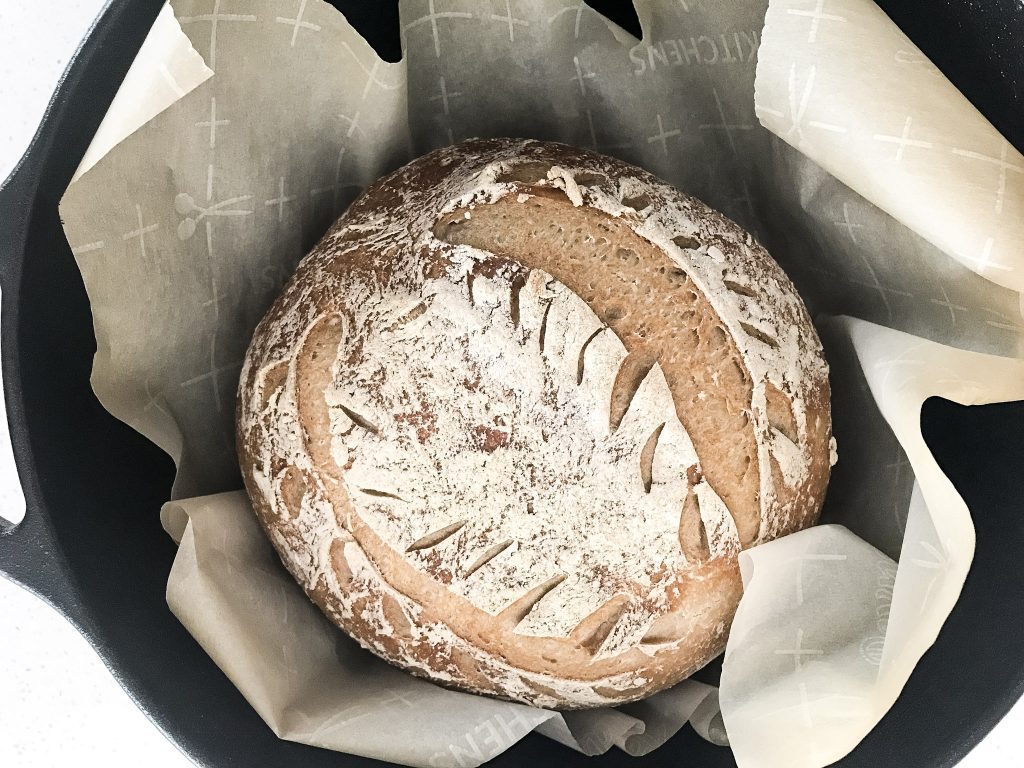
Although traditionally fermented sourdough bread
is easier to digest because of the gut-friendly bacteria, yeasts, and enzymes, it often still contains gluten. Making it unsafe if you or a loved one has Celiac Disease.
That’s where our story starts. When my second oldest daughter was 2, I knew something wasn’t right. My aunt has Celiac Disease and I had heard her experiences as a child. The descriptions sounded just like R. After a false negative, it was another 3 years before I got a doctor to listen to my mama gut that something was wrong. We did lots of tests and the diagnosis came back as positive this time, as did the biopsy results.
I had been making sourdough bread before this but stopped after this. The transition to strictly gluten-free was already going to be tough, without the delicious smell of home-baked bread wafting through the air.
Thankfully a friend shared some starter and this recipe a few years ago. So fresh-baked bread can still happen in our home for her and me, who has a gluten sensitivity. We are so glad to have a good gluten-free bread recipe to use at home to replace the regular bread I used to make.
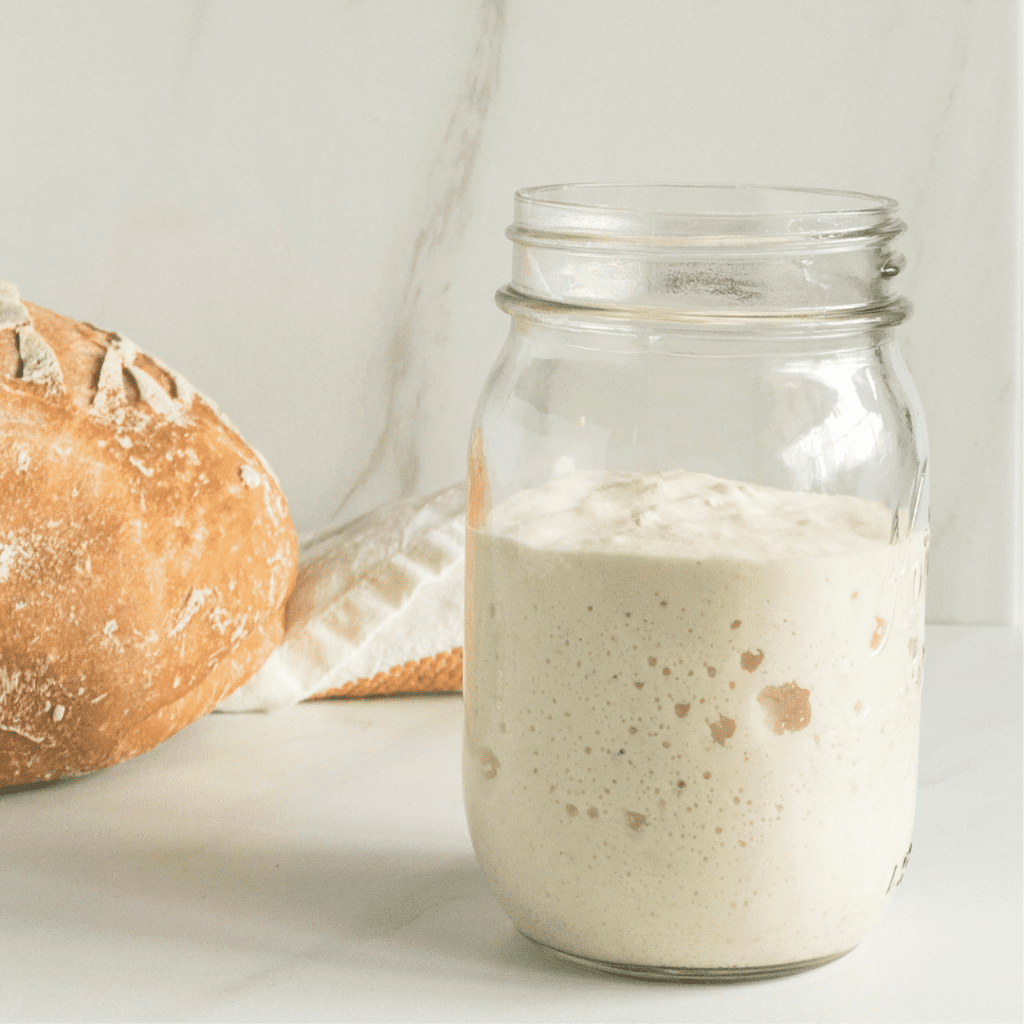
Please note that this post may contain affiliate links. As an Amazon Associate, I may earn commissions from qualifying purchases, at no additional cost to you. Thank you for supporting our family in this way from my affiliate link.
Where to Get Gluten Free Sourdough Starter
Obviously having a gluten-free starter is the key ingredient, but it isn’t always easy to come by. Cultures for Health Gluten Free Sourdough Starter has one for a decent price on Amazon. You will need to first activate it with rice flour and then slowly transition it to King Arthur measure for measure. (I cover how to do this in my post about how to activate a gluten-free sourdough starter)
For brown rice flour I use Bob’s Red Mill Organic Brown Rice Flour. They also have a none organic version, Bob’s Red Mill Gluten Free Brown Rice Flour.
There are also some sellers on Etsy that you could order some gluten-free sourdough starter from.
If you do order it online, it will most likely come dehydrated. It will probably arrive with their directions of how to activate it.
But if you need some extra help or want to see how I have rehydrated mine, you may find this post helpful: How to activate a gluten free sourdough starter.
Another way to get some starter is by making your own gluten-free sourdough starter like Lisa from Farmhouse on Boone has a tutorial of starting one over on her post Gluten Free Sourdough Starter.
I have had a few friends try to make their own from various recipes, and I will just warn you that it can be tricky. You have to follow the steps carefully and be patient.
Equipment Suggested to Create GF Sourdough Bread at Home
- Digital scale: A digital kitchen scale is really a must for GF baking as ingredients can vary so much. But if not possible, I will include a version of the recipe that uses standard measuring sizes.
- Glass or ceramic bowl: I use the biggest one from this set. Metal can negatively react with the dough causing it to not rise well.
- Banneton Basket: Optional but recommended in the long term. I have a kit like this, Round Bread Banneton Proofing Basket for Sourdough kit.
- Dutch Oven: Personally I think a dutch oven gives the best crust. I have used a regular loaf pan and had good results. But the crust can get fairly tough without a cover to help trap the steam.
- Dough Scraper: plastic is best, once again because of the chance of reacting with the dough. This comes in handy when scraping the counter or your hands when kneading the dough. It will get sticky. One is included in the Banneton Basket kit.
- Digital Thermometer: With gluten-free baking, always bake the recipe until it has come to an internal temperature of 210 degrees Fahrenheit. (98.9 degrees Celsius.) This is the digital thermometer I have.
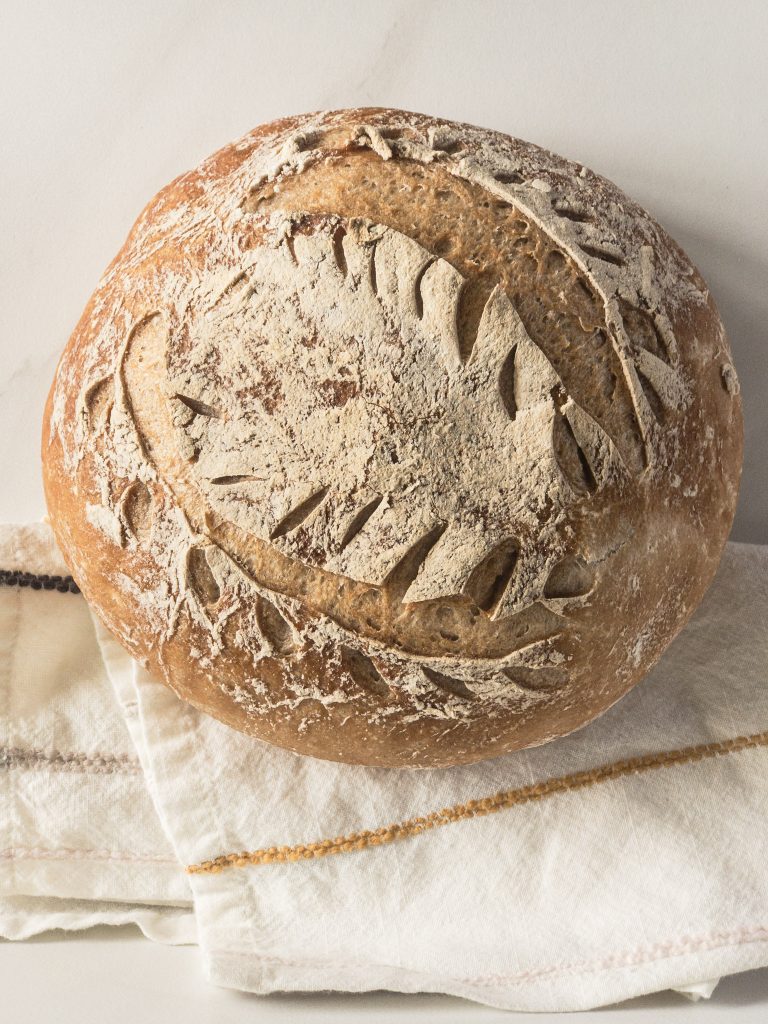
Gluten Free Sourdough Bread Recipe
Ingredients
460 g King Arthur’s GF Measure for Measure flour or 3 3/4 cups
20 g psyllium husk or 2 Tablespoons + 2 tsp
9 g sea salt or 1 Tablespoon
Mix the dry ingredients listed above, together
90 g recently feed gluten-free sourdough starter or a little less than 1/3 cup (See note about timing below.)
500 grams purified water or 20 oz Start with 500 grams and work up to 575 grams if needed.
Directions
- Mix together with a wooden spoon till it is loosely combined. (Any utensil that is not metal will do)
2. Turn the mixture out onto a GF floured surface and knead/ work into a ball for at least 3 minutes.
3. Set in a banneton basket or medium-sized glass bowl overnight.* Covered with a light towel.
The Next Day:
4. In the morning, it should have expanded/ risen some. It doesn’t double in size like traditional gluten-based bread but should have some spring to it.
5. If using a dutch oven: Turn out dough onto a piece of parchment paper and shape it into a ball. Let it rise for an hour.*
6. 30 minutes into the rise time, place the dutch oven into the oven and turn it on to 450 degrees to preheat.
(Alternatively if using a loaf pan, butter the bottom of a loaf pan and turn the dough out into the pan. Let it rise for an hour.* You will not be placing the pan in the oven to preheat.
7. When the oven is preheated and the dough has risen, carefully score or cut a design into the top of the loaf. (Just into the top crust, do not cut deep into the loaf.)
8. If using a dutch oven: Carefully remove the hot dutch oven to a heat-protected workspace. Remove the lid, (watch out for steam), and carefully place both the loaf and parchment paper inside of the dutch oven. Put the lid back on and the dutch oven into the oven.
(Alternatively, if using a loaf pan, place the pan into the oven. No additional steps are necessary. Bake for 1 hour.)
9. If using a dutch oven: bake for 50 minutes covered, then carefully remove the lid for the last 10 minutes of baking time. Bake for 1 hour total.
10. Let bread rest in pan/ dutch oven for 10 minutes and then remove loaf to a cooling rack.
11. Let it completely cool before cutting into it to let the “crumb” set. But I also won’t blame you if you can’t help it. Enjoy!
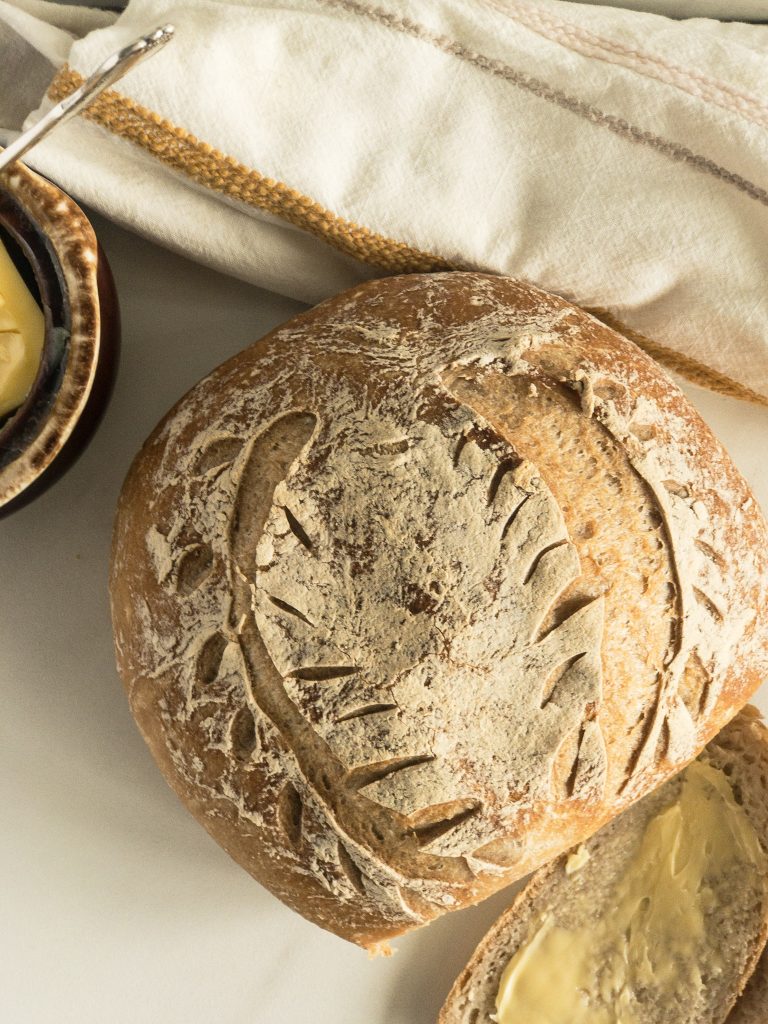
Tips for a Successful Loaf of Gluten Free Sourdough Bread
I have had the best results using King Arthur’s gluten-free Measure for Measure flour mix. It is widely available and has a good price per ounce on Amazon.
Only use purified water. I am on city water (tap water) that has chlorine added, so we have a Berkey water filtration system. Before we had that though, I would buy gallons of purified water at the grocery store. Chlorine kills microbes. (Another reason to not drink it.)
Proof your dough in a medium-sized bowl. If it is too small, it will overflow. Too large and it will fall flat. I feel like I’m writing the story of Goldilocks, but the medium size is just right for this recipe.
Invest in a kitchen scale. Gf baking works best with a scale and your results will be more consistent if you use one.
Psyllium husk gives this gluten-free sourdough some chew but also helps it be vegan friendly. I get mine here. You want the whole husk, not psyllium husk powder.
Bake for the full amount of time. The internal temperature should be at least 210 degrees Fahrenheit.
Let the bread cool COMPLETELY before slicing it. I know this is going to take some willpower. I’ll admit, I’m not always successful in temptation. But keeping all the inner heat inside to slowly cool down will give you the best results and a happy “crumb”. (A term referring to the inside texture.)
It will be slightly gummy or squishy because of the nature of GF flours as well as the psyllium husk.
I like it best toasted.
Thank you for stopping by and I hope this recipe is helpful to you! If you ever need some quick gluten-free dairy-free snack ideas, I wrote a post about our favorite 100 snack ideas from the grocery store. You can check out the 100 gluten-free dairy-free snack ideas here.
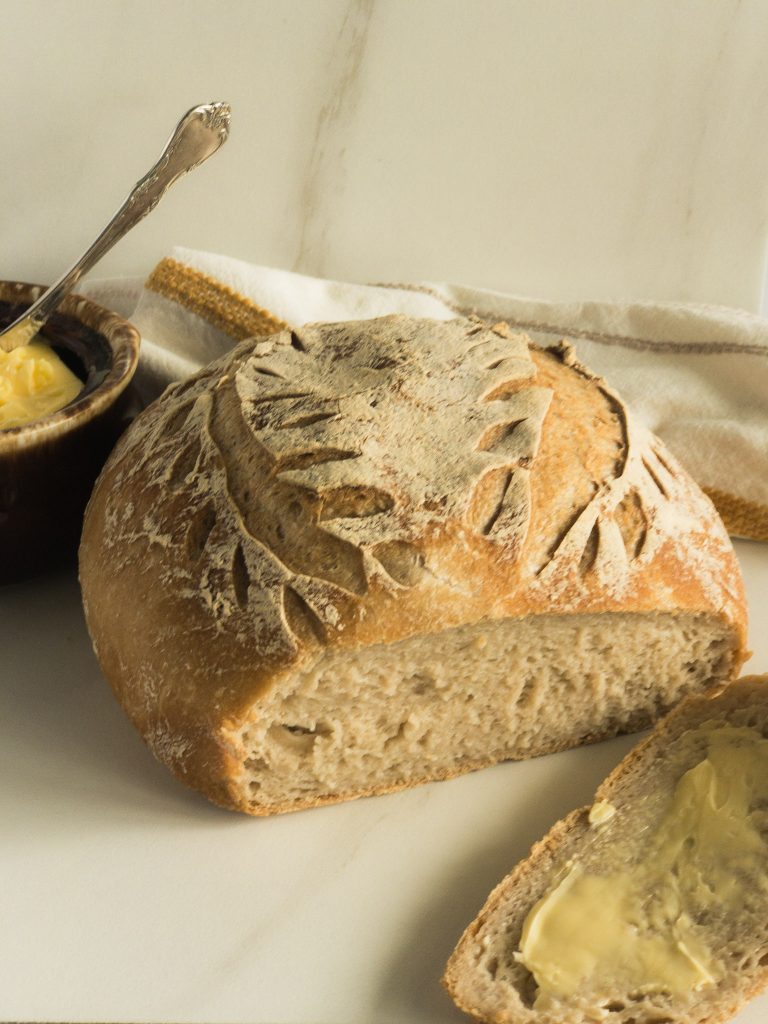
Notes about Timing
I plan to bake my loaf of bread first thing in the morning. But in order to do that, some steps need to occur ahead of time and it looks like this.
Usually, the night before I plan on baking, I feed my Gluten-Free sourdough starter around dinner time. (6 pm for me.)
Then around 9 pm, I mix the dough together, following directions 1-3.
In the morning I move on to the rest of the steps 4-10 so that by lunchtime it has had time to cool and we can eat it.
The learning process can take some getting used to but it is worth it for me to incorporate this into our home. I love to nourish my family in this way!
Trouble Shooting
The texture will be sticky when mixing it. It’s just the nature of GF flours and adding the Psyllium husk adds to that. But there are some things to try if you find it is not at all workable.
Make sure to be using King Arthur’s Gluten-Free Measure for Measure Flour
Things to try:
What if it is too sticky:
- Add a little more GF flour at a time till it gets manageable.
- A digital scale is highly recommended. If using dry measurement cups and liquid measurement glasses, ingredients may need to be adjusted for the right consistency.
- When using a digital scale, make sure you are measuring in grams.
If it is too hard: Your oven may be too hot.
- Every oven is different. Try decreasing the temperature to 425 degrees, but don’t adjust the bake time too much. This could result in an unbaked center.
If it is soupy:
- Adjust the amount of water. Next time have the full amount of water ready, but add a little at a time while you stir the ingredients together. You want the consistency to be evenly moist without too much liquid.
Frequently Asked Questions About How to Make Gluten Free Sourdough Bread
What types of flour are in King Arthur Gluten Free Flour? (Measure for Measure)
The ingredients in the Measure for Measure Gluten Free flour from King Arthur: White rice flour, whole grain brown rice flour, whole sorghum flour, tapioca starch, potato starch, cellulose, xanthan gum, vitamin, and mineral blend.
Some different flours that are called for in other gluten-free baking applications that are not used in this gluten free sourdough recipe are oat flour and buckwheat flour. I haven’t had as much success with other flour blends but am always experimenting.
Why isn’t my gluten-free bread rising?
Because a sourdough starter is from capturing wild yeast, the fermentation process can widely vary. First off, make sure you have an active starter by feeding it a few hours before mixing up this gluten-free sourdough bread recipe. After you mix it (step 3) and place it in a banneton-proofing basket or medium-sized glass bowl, make sure to leave it in a warm place to allow the dough to rise at room temperature for the bulk fermentation process.
If your home is cold in the winter months, try placing it on top of your refrigerator or on the countertop above your dishwasher if you run it overnight.
Do I need a stand mixer to make this gluten free sourdough bread recipe?
No, I just use a wooden spoon and my hands to mix the dough till combined.
More Gluten Free Sourdough Recipes
Once you start making gluten free sourdough bread, you probably will want other ways to use your gluten-free sourdough discard or starter.
This Gluten Free Sourdough Skillet One Pot Healthy Meal with Starter Discard is one of our go to weeknight meals!
And you can always check out my entire Gluten Free sourdough category too.
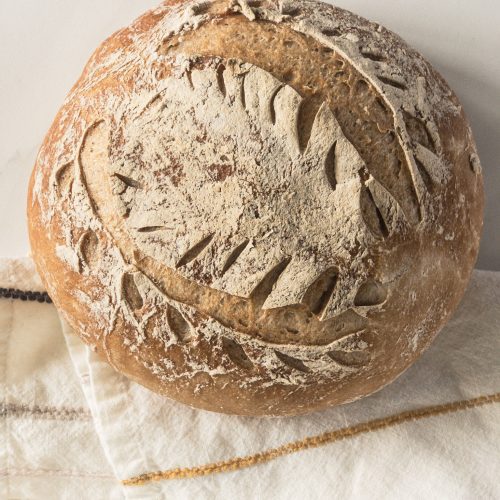
Gluten Free Sourdough Bread
Equipment
- Digital scale
- Glass or ceramic bowl
- Banneton basket: Optional but recommended in the long term.
- Dutch Oven
- Parchment Paper if using a dutch oven
- Dough Scraper
- Scoring Blade or sharp knife
- Cooling Rack
Ingredients
- 460 grams King Arthur's Gluten-free Measure for Measure flour or 3 3/4 cups
- 20 grams Psyllium husk or 2 Tablspoons + 2 tsp
- 9 grams Sea salt or 1 Tblspoon
- 90 grams Recently feed gluten free sourdough starter or a little less than 1/3 cup
- 500 grams Purified water (or about 17 ounces.) Start with 500 grams and work up to 575 grams if needed. (20 ounces)
Instructions
- In a large glass bowl, mix together the GF flour, psyllium husk and sea salt.
- Add in the wet ingredients of the GF sourdough starter and water
- Mix together with a wooden spoon till it is loosely combined. (Any utensil that is not metal will do)
- Turn the mixture out on to a GF floured surface and knead/ work in to a ball for at least 3 minutes.
- Set in a banneton basket or medium sized glass bowl overnight.* Covered with a light towel.
- In the morning, it should have expanded/ risen some. It doesn't double in size like traditional gluten based breads but should have some spring to it.
- If using a dutch oven: Turn out dough on to a piece of parchment paper and shape it in to a ball. Let it rise for an hour.*
- 30 minutes in to the rise time, place the dutch oven into the oven and turn it on to 450 degrees to preheat.
- (Alternatively if using a loaf pan, butter the bottom of a loaf pan and turn dough out in to the pan. Let it rise for an hour.*)
- When the oven is preheated and the dough has risen, carefully score or cut a design in to the top of the loaf. (Just in to the top crust, do not cut deep in to the loaf.)
- If using a dutch oven: Carefully remove the dutch oven to a heat-protected workspace. Remove the lid, (watch out for steam), carefully place both the loaf and parchment paper inside of the dutch oven. Put the lid back on and the dutch oven into the oven.
- (Alternatively, if using a loaf pan, place the pan in to the oven. No additional steps necessary. Bake for 1 hour.)
- If using a dutch oven: bake for 50 minutes covered, then carefully remove the lid for the last 10 minutes of baking time. Bake for 1 hour total.
- Let bread rest in pan/ dutch oven for 10 minutes and then remove loaf to a cooling rack.
- Let it completly cool before cutting in to it to let the "crumb" set. But I also won't blame you if you can't help it.
Notes
Tips for a successful loaf of Gluten-Free Sourdough Bread
When mixing/ kneading, it can be very sticky. Refer back to the post under “Trouble Shooting” for help. I have had the best results using King Arthur’s gluten-free flour mix. It is widely available and has a good price per ounce. Proof your dough in a medium-sized bowl. If it is too small, it will overflow. Too large and it will fall flat. I feel like I’m writing the story of Goldilocks, but the medium size is just right for this recipe. Invest in a kitchen scale. Gf baking works best with a scale and your results will be more consistent if you use one. Psyllium husk gives this gluten-free sourdough some chew but also helps it be vegan friendly. Bake for the full amount of time. The internal temperature should be at least 210 degrees Fahrenheit. Let the bread cool COMPLETELY before slicing it. I know this is going to take some willpower. I’ll admit, I’m not always successful in this temptation. But keeping all the inner heat inside to slowly cool down will give you the best results and a happy “crumb”. (A term referring to the inside texture.) It will be slightly gummy or squishy because of the nature of GF flours as well as the psyllium husk. I like it best toasted.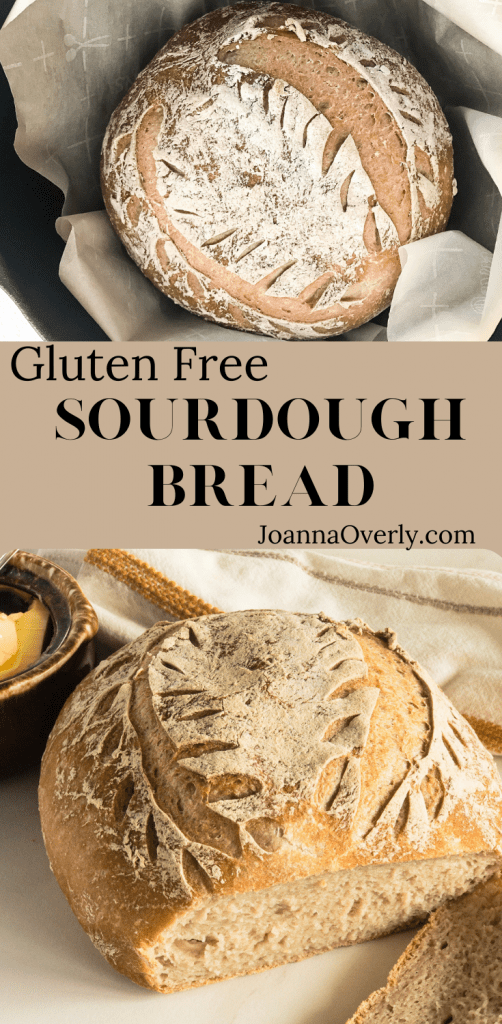
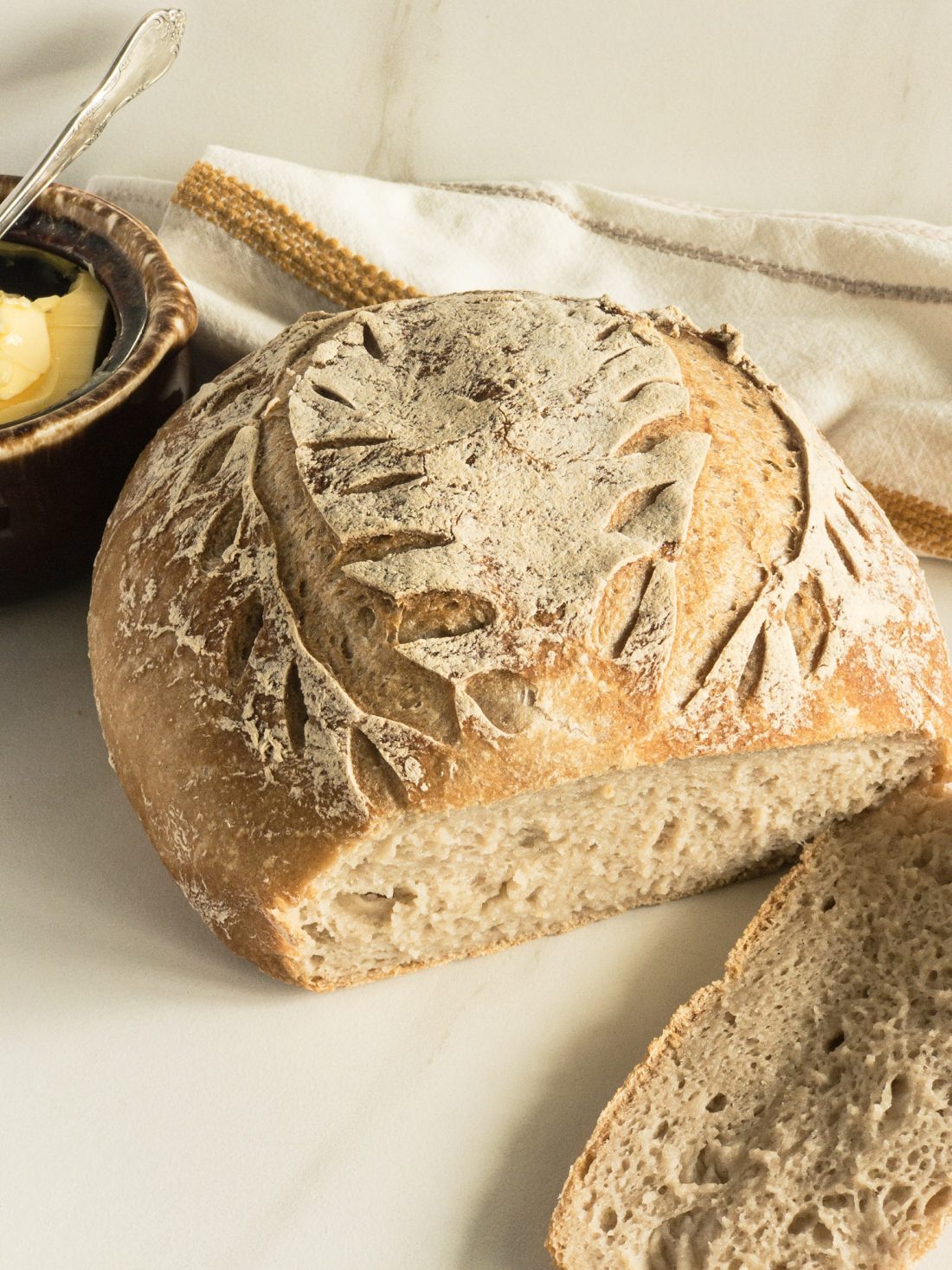
Such a great recipe. It’s so nice to find a great gluten free bread recipe.
Thank you! Gluten free can be tricky but I enjoy it. 🙂
This looks really good! I started to go gluten-free. I will try this recipe. Thank you!!! 🙂
I’m so glad you think so! Let me know how it goes. 🙂
This sourdough bread look amazing! I will have to give it a try. Thanks for sharing!!
You’re so kind! Thanks for stopping by.
Your bread looks so pretty and tasty!
Thanks so much!
Hi friend! Thanks for the recipe! How do you make your bread have that beautiful design on top!?
Hi back! I use a blade or knife to make designs just before popping it in the oven. 🙂
Hello, I followed the directions but when it came time to knead it was way too sticky. What could’ve went wrong ?
Thank you!
It for sure will have a sticky texture and can be a bit of work to knead. You can add more GF flour to get a texture that is more workable but if you did that and it still was unworkable, it may be a difference in some of the ingredients. What Gf flour are you using? Do you have a kitchen scale or using the measurement guidelines? I’d love to help make it work for you!
Hi there
Just wondering what is the substitute for gluten free starter
Hi there, I’m sorry to say that there I haven’t tried any substitutions for the gluten-free starter for this recipe. GF sourdough starter is a form of wild yeasts, so yeast may be able to be substituted but I haven’t tried to.
Hello! I am so excited to try this recipe. I have mixed the dry and now the wet ingredients and I have soup, not dough! I have double checked my measurements, but the 575g of water just seems too much? I double checked everything- how “wet” is your dough?
I’m so sorry that your mix is so wet! I had this happen with another friend and we tried trouble shooting it. It seems to be a difference in the starters. I would suggest next time only using half the amount of water to start and see how that comes together, adding a little at a time till there is a workable consistency. Please let me know how that goes! Best wishes on your sourdough journey
Hi there! I am SO excited about this recipe! It’s my first time making sourdough! Quick question though, when you leave it to proof overnight, do you place it in the fridge or leave it on the counter? Thanks so much!!
I’m so excited to hear how it goes for you! I leave it on the counter to proof overnight. If you’re in a cool climate for the winter, it may take longer to proof in the cold. Instead of baking right in the morning, I do it about noon.
Have you tried proofing it overnight in the fridge?
Does proofing it on the countertop make it sour? I don’t like my sourdough too sour, I like them very mild. Trying to go gluten free for some health issues of mine and not willing to let go of sourdough making! Lol thank you for the easy recipe!
I want to make this and I have everything except for the husks…I do have psyllium husk POWDER…do you have any suggestions of how much powder I can sub? I assume less…like if you would take the same amount of husks and pulverize them, how much powder do you get?? thank you!
I actually used to use powdered psyllium husk in this recipe without changing anything! So I would go for it. 🙂
Do you have to use psyllium husk? How would I need to alter the recipe if not available?
I would not omit the psyllium husk, as it is a binder for the lack of gluten. Maybe try xanthan gum, but I haven’t experimented with that.
I can buy King Arthur GF All Purpose Flour or Measure for Measure. Which should I choose for this recipe?
Hi Jude, I use the measure for measure. 🙂
Making this tonight. Excited to try my first bread recipe!
yay! I hope it goes well for you. GF bread is always a little tricky but you can do it!
Can you explain further the shape into a ball phase? Because coming out of the banner on basket it’s already shaped. Mine kind of acted weird at this phase and I didn’t really know what to do.
I just gently reshape any edges that may have gotten wonky when flipping the dough over.
I have a question about the amount/weight of the psyllium husk. When I weigh 2 TB +2 TS of psyllium husk, it comes to 10 grams. I’m using the Anthony’s psyllium husk.
Hi Sam, I just measured again and 2 Tablespoons and 2 teaspoons for me is about 14 grams, which is still a discrepancy. This is why I recommend using a scale as there are lots of variables between products, (even the same products) climate (humidity, altitude, etc…) that affect baking, especially gluten free baking. Since you have a scale, go ahead and measure it out with that at 20 grams. I hope that helps!
Thanks so much, Joanna. Just making sure that 20 g was the correct amount. I’m about to make another loaf, so I will use 20 g.
You’re very welcome! Happy baking 🙂
So excited for this recipe—however my first time trying it, the inside came out uncooked, everything outside looked great.
Do you usually measure the temp before removing the lid to make sure it’s cooked thouroughly? I’m wondering if that’s what I should do
It could very well be a difference in ovens, so I would play around with the timing. If you want to test the internal temperature before taking the lid off for the second timing, make sure it is near 200 degrees Fahrenheit. To be fully cooked you want it at 210 degrees Fahrenheit, so that extra time with the lid off should get you fully there.
Hi Joanna, thank you for the recipe! Any tips/thoughts on the bread looking so pale? Yours is so pretty and brown and toasted looking. Mine looked white and not pretty at all. It tasted great but it looked so sad compared to yours.
Hi Allison, sorry I’m just seeing this now! Are you using a dutch oven to help with the crust? That is probably a key part in the crust forming like this. When I do it in a bread loaf without the dutch oven, it looks more pale.
Where do you get your GF sourdough starter?
Hi Tricia, I got some from a friend. But Cultures for Health carries some or you can try making one from scratch. Best wishes!
Hi. I just found the various comments. So excited. First, I made my first GF sourdough starter—using King Arthur’s Measure for Measure, found it on Google. Also found your recipe!!!! I can’t rate it yet because I could NOT find KA GF All Purpose Flour in any of the WV stores. I did find Bob’s Red Mill. Also used Pscillium Husk Powder versus whole husk. And, used less water than you called for–just until the ingredients came together. All told the dough was actually lovely to work with. It did rise not not a huge amount overnight or much more this morning. And, forgot to put the cuts into the top before baking. Used dutch oven. All that said, for a first effort I am pleased. The taste was lovely. Loved your timelines, the troubleshooting, the photos. You got me started.
Hi Gail, so glad you have found this recipe to be helpful! I hope you have much success with it and enjoy it 🙂
Just curious if the photo is the actual bread from this recipe or if it’s a stock photo?
Hi Cori, this photo is my own of this gluten free sourdough bread recipe. Not a stock image.
I live in a hot climate, I have made this 3 times and it Tate’s good but doesn’t rise in the oven. Maybe the overnight rise in the tropics is too much? It’s about 25c overnight here currently. Should I proof in the fridge instead? Thank you
I live in a hot climate, I have made this 3 times and it taste’s good but doesn’t rise in the oven. Maybe the overnight rise in the tropics is too much? It’s about 25c overnight here currently. Should I proof in the fridge instead? Thank you
Hi! Yes I would definitely give it a try in the refrigerator than for the overnight proof. Another thing that comes to mind is wondering how established your starter is? If it is fairly new, it may do better over time as it strengthens with age. As it builds up more captured wild yeast strains. Let me know if the overnight proofing in the fridge helps!
I dont have psyllium husk on hand but I have milled flax — have you tried this substitution? Hopeful this may work so I dont have to run to the store!
Hi Allison! I have not tried milled flax as I think it will just add to the gumminess. I know, psyllium powder is not something a lot of people keep on hand unless the do a lot of gf baking, but it is so helpful for “the chew” of the bread crumb.
Hi Joanna! I just started my first loaf this evening! Excited to see how it bakes up in the morning! I have a question about the starter, I still have about 1 1/2 cups left. Do you continue to feed it? Can the starter be put in the fridge till I am ready for the next load? I used the Cultures for Health GF Starter and followed your instructions to change it over to King Arthur’s GF Measure for Measure.
Hi Emily! You will want to keep feeding it to keep it alive but you can place it in the fridge for about a week at a time between feedings. If you end up having too much starter left over, look up discard recipes to use it for other things. I have a few recipes here but am always working to get more up. Just make sure to save some starter and don’t use it all up since you did all that work to get it going! Hope this helps 🙂
The bread tastes amazing, I checked the internal temp and it was 200 before removing the lid however my bread was SUPER doughy when we cut into it. Any idea what causes this?
Hi Jessica, once you took the lid off did you continue to let it cook for another 10 minutes?
Yes I did, I am making another loaf tomorrow and will let it cook a little longer and update! Thank
Hi there. Do you cover the dough as it rises on the counter? Thanks, super excited to try this.
Hi Leslie! Yes, I cover the dough with a tea towel while it rises on the counter.
Hi Leslie, yes I cover it with a tea towel!
What should the size be about in diameter?
Can you tell me how many calories and total carbs?
Hi Mary, I’m sorry but I don’t have that information at this time.
My boule looks amazing! It’s cooling now and I cannot wait to cut into it. This is the 3rd recipe I’ve tried and it looks the most fluffy and springy so far.
Do you happen to know the fat and carb count per serving? I see the calorie count but that’s it.
Thanks!
I’m so glad it’s looking promising! Way to go! I’m sorry though, I don’t have fat and carb counts for the recipe.
I can only have the Namaste or Montana GF flour mixes as I can’t have potato starch. I’m still learning about these flours, and my starter is a brown rice flour starter. Would I have any issues using those in this recipe?
Hi Amber, I really can’t say how it would work out but I think it’s worth a try!Best of luck
If mixed my loaf together this morning (9am-ish) do I still let it sit overnight? Or what is the actual first rise time?
Rise times will very based on many aspects but room temperature is a big one. So depending on your climate, it can be 8-12 hours at room temperature. If you mixed it in the morning, I would let it rest covered with a light tea towel on the counter until it looks like it’s expanded. (It won’t fully double like regular wheat bread) If it’s too late in the day to then bake it, I would tuck it into the fridge overnight and then bake the following morning.
My dough seems too dry. It’s cracking after proofing. Any thoughts? I’m waiting for it to proof for an hour and then baking. It’s so dry after the over night proof
You could spritz the top with a little bit of water for now and the next time increase the water a bit.
Mine turned out purple any ideas?
Hey Ashley! That can happen depending on the psyllium husk that you use. Doesn’t affect its taste but can be a surprise!
This bread is ABSOLUTELY AMAZING! It’s so easy and it works every time! It’s so crusty on the outside and soft on the inside!! Love it! Thank you!!
Oh thank you Victoria for your kind words! I’m so glad you like it
If I want to add some add-ins, what step would that be at. I’m think cheddar and jalapeños.
You know, I haven’t tried add ins! But that sounds delicious. Maybe try folding them in in the morning and let it rise more than the 30-60 mins before baking. I wouldn’t add it at the beginning as that may mess with the texture by adding extra moisture.
How did you start your starter? With what gluten free flour? I have what I thought was a mature gluten free starter with KA 1:1.
Hi Aleah, yes I started with King Arthur measure for measure gluten free mix.
My loaf is ready for its overnight proofing. I’m wondering the best way to store the bread after baking. Can it be frozen? I’ll be the only one eating it in our house and don’t want it to go bad or moldy.
Hi Kara! Yes you can freeze it but I would suggest slicing it first so that you can just grab a few pieces at a time as needed. Enjoy!
Hello, my loaf did not split this time. Any ideas why?
Hi Tanya, there could be a few different reasons why your loaf didn’t split. Did you score it with a blade or knife? Sometimes if it’s not a deep enough cut, it won’t open up much.
Another couple reasons it may not split is that it may be lacking moisture to produce enough steam. Or perhaps the starter wasn’t as active this time to give it this boost. Gluten free bread can be tricky some times but I hope it works out well for you next time!
Hi! Love the addition of psyllium! More gut health! . I made this with the cultures of health GF starter and it turned out pretty! I will say mine seems slightly more dense that yours it didn’t rise but like 10% overnight. I did you bobs red mill 1to1 flour. Maybe that’s it?
Hi Kelly! Yes, love gut health! The bobs red mill gf flour mix may be a reason it didn’t rise much but I’d also say, if you’re in a cold climate, with it being winter, that plays a part. the cold slows the fermentation process and things rise quicker in the summer. So I usually will place my loaf on the counter top above my dish washer since I run it at night, it gets a little warmer. Or others use the top of their fridge for a warm spot. It also could be that your starter isn’t as mature yet and as time goes on, it gets stronger for more rise. Keep trying!
I’ve made this 2x now and it just doesn’t turn out right. Same exact ingredients, my sour dough starter is active every day after feeding. But the crust looks lighter and the inside is dense and almost purple looking?? Tastes pretty good, but I want it to look like the picture. Any tips?
Hi Courtney, sourdough can be tricky, especially gluten free! The slight purple color can be from the psyllium husk, but is still totally fine to eat. To deal with the issue of the crust being lighter and inside more dense, I would try baking it for longer. It sounds like it may just be under baked for your specific oven. Just keep tweaking what works for your kitchen as each environment changes things a little bit. Good luck and don’t give up!
I’m excited to try this. What size ditch oven works? I have a 9-quart round and a 4-quart oval.
Its a fairly large loaf so I would say the 9 quart round.
5.5 quart works well
Thank you for the recipe. My son in law has been gluten free for years. He says this is the best gf bread he has ever had. Success!!
Just made this recipe! So easy to put together. It’s the first time I’ve left my dough to proof overnight on the counter. I usually do a cold retard overnight. It turned out great! Glad to have a reliable recipe in my list. Thank you!
Hi! Just curious – Why knead for 3 mins if there is no gluten?
It helps to evenly hydrate the ingredients. I have found it a better technique than using a mixer.
We love your bread recipe!!! Thank you for sharing the inside is perfect. The crust is so hard though. Am I doing something wrong?
HI Michele, is the bottom of your loaf? I put an empty cookie sheet or pizza sheet on the lower oven rack beneath my dutch oven to help disperse the heat a bit more. This could help!
Hey Joanna,
I read that regular sourdough bread that has been fermented for 7 hours or longer is considered gluten free (less than 20 ppm of gluten). Do the have any information on this?
Hi Cheryl, I do not have any information on regular sourdough bread as that relates to that. I know some of my friends that are gluten sensitive can handle a long fermented sourdough loaf but with my daughter who has Celiac, we don’t mess around with any wheat based products for her.
King Arthur’s GF flour is not the same as measure for measure.. just happen to click on your link to amazon and surprised to see a different flour than is on your ingredients list.. no wonder i had problems
Hi Tony, I’m not sure which place I listed a different King Arthur’s GF flour. I mention to be using the measure for measure gluten free blend many times in the post but will add even more clarification so that other’s wont get mixed up. I’m sorry you have had troubles! I tried to make it as clear as I could.
I followed the recipe exactly but my dough did not rise overnight. My starter is two or so weeks old and was very active after feeding. What did I do wrong? Please help. …thank you
Hi Stephenie, did you try to bake it and see how it did? 2 weeks old is still fairly young for a starter so don’t be discouraged! Is your house very cool? It may need longer to rise in the winter than just overnight. Try again and keep at it, it is an art. It usually takes a bit of work to learn how to work with sourdough as there are multiple things to take into consideration for each individual kitchen, but the payoff is worth it. 🙂
I’m looking to make this recipe. I saw in comments confusion about the flour.King Arthur flour Gluten free flour says measure for measure under the title. It is not measure for measure gluten free brand of flour. Hopefully that helps someone. When baking in a loaf pan do you encourage a tray also i the oven with water to help with moisture? Or is in a Dutch oven add ice cubes between the sides of parchment paper and bowl to help trap moist when the lid is closed? Or instead of adding water in the recipe use a carbonated beverage like 7up or gluten free beer? If open loaf pan or Dutch oven cooking do you encourage flouring the dough and applying olive oil?
Hi Krista, I haven’t found it necessary to add water to the oven to create steam when baking in a loaf pan. I also haven’t tried adding other things either for carbonation but feel free to experiment! The recipe as posted is what is pictured, I didn’t withhold any steps for that outcome. Adding a touch of olive oil to the top would help brown it some but I personally don’t like adding olive oil to items that bake at such a high temperature. Avocado oil would be my choice if you’d like to add some oil to the top for browning it.
I’m looking to make this recipe. I saw in comments confusion about the flour.King Arthur flour Gluten free flour says measure for measure under the title. It is not measure for measure gluten free brand of flour. Hopefully that helps someone. When baking in a loaf pan do you encourage a tray also i the oven with water to help with moisture? Or is in a Dutch oven add ice cubes between the sides of parchment paper and bowl to help trap moist when the lid is closed? Or instead of adding water in the recipe use a carbonated beverage like 7up or gluten free beer? If open loaf pan or Dutch oven cooking do you encourage flouring the dough and applying olive oil?
My first attempt at making gf sourdough came out like a hard rock. I then tried this recipe and WOW! Incredible. Probably the best bread I’ve ever had. It’s slightly undercooked but that is probably my oven. Thank you so much!!!!
I’m so glad you had success! Thanks for sharing 🙂
My dough will rise the 1st rise, but it will not rise the 2nd time. My house is cool, so I set it in the oven with the light on for 3 hours and still does not rise. What am I doing wrong.
Hi Jennifer, there could be several reasons why your dough isn’t rising. First question I have is, how old is your starter? A cool house definitely does make the rise time longer. Did you bake it to see how it worked? The more you make the recipe, the more you will be able to fine tune it.
I left it to rise on the counter (65 degrees) for 24 hours. It has a purpleish hue, which i read above and that could be the psyllium husk, but it also has some spots that look almost like mold.
Is 24 hours too long to rise, and therefore it’s moldy? I have a one week old starter- so very young! This is my first try.
Hi Cassidy, I wouldn’t do 24 hours on the counter. If you mix it and aren’t able to bake it for 24 hours, I would put it in the refrigerator. It’s hard to say if it was mold without a photo but if you are worried about that I would try again. Sometimes the gf flour mix can look a little spotty from dusting the bowl/ banneton basket but if it looks more spotty than it first did after shaping it and setting it to rise, I would probably toss it and try again. One week is young for a starter but it will get stronger! Best wishes in your baking.
I dont live where you can get the flour… most of the flour here I have to grind myself as this country doesn’t seem tp see alergies…. can you surgest à flour mix please
Hi Jo! I’m sorry but I don’t have a recipe to match the King Arthur Gluten Free Measure for Measure. I wish I did!
Amazon!!!
Hi, after putting in the banneton basket or bowl, is it put in the fridge overnight? So excited to try this. Thank you!
I usually just leave it on the counter top overnight. You could do it in the fridge over night though to “retard” the dough a bit and have a longer ferment.
Hi! I tried this last night with an extremely active starter and it rose overnight, not a lot when it sat out the next morning, but it came out extremely dense and squishy, even though it seemed one and the bottom was extremely hard, and tough to cut through.
i followed all the instructions, i’m wondering what i did wrong?
Hi there! What are you baking the loaf in? Is it a dutch oven or a loaf pan? Some ovens need some extra help with heat distribution so you can put another baking sheet on a lower rack beneath what you are baking in. This helps distribute the heat more evenly so the bottom doesn’t get so tough. Squishy-ness could be that it wasn’t baked long enough. The internal temperature of the loaf should be 210 degrees Fahrenheit. Also, you need to let it cool completely before slicing into it to let the crumb set. It is a gluten free bread and does have some squish and gum to it that I am working at fixing, so it won’t be completely squish free but it shouldn’t be extremely dense and squishy. I hope these tips help!
I’ve made this recipe for myself and my gluten free friends several times and it always turns out fantastic! I live in the UK and used Dove’s farm bread flour.
I just made this boule and it is one of my best, so far! I used a silicone trivet to form a fancy top while it was proofing. I wish I could add a pic of the final product. Thank you for sharing your knowledge, experience and recipe.
I made a gluten free sourdough starter with king arthurs Measure for measure. So to make this bread can I use that starter in this recipe? I also need King arthur”s gluten free flour not measure for Measure?
Hi Kathy, yes you can use that starter in this recipe! The kind of gluten free flour mixture called for is the King Arthur’s Measure for Measure. It is sometimes referred to as gluten free flour in the recipe but the measure for measure is the preferred gluten free flour mix.
Hi! I’m excited to try your recipe. Question-? I have round roasting pans to bake the bread in vs.Dutch oven. Any alterations I should make fur bake time/ temp, etc. thank you
Hi Mary! I’m so glad you’re going to try it out! I would follow the loaf pan instructions and test it out that way. I haven’t tried it with round roasting pans before so I can’t specifically speak to that but the loaf instructions would be the best way to start. Happy baking!
Do you put the Whole Psyllium Husk in the wet or dry ingredents? Some recipes I have seen say to soak the Psyllium husk first. Do I need to do that for this recipe? Thank you for your help!
Hi Dawn, in this recipe the psyllium husk is added to the dry ingredients. 🙂
Hi, Joanna, I make your bread all the time. It looks and tastes wonderful. Just wondering if you tried making rolls with this recipe?
Thank you
Hi Petra, thanks so much for commenting! I haven’t tried making rolls with this recipe yet but let me know if you do!